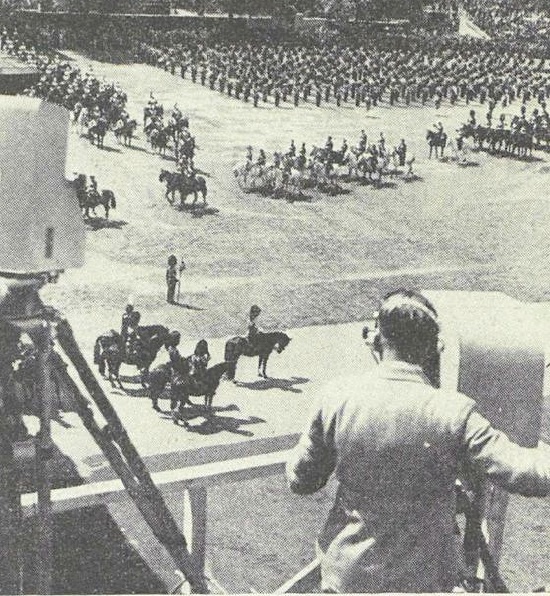OTD in early British television: 9 June 1938

John Wyver writes: On the morning of Thursday 9 June 1938 the BBC’s mobile control room provided an 80-minute outside broadcast from Whitehall of the King’s Birthday Parade, otherwise known as Trooping the Colour.
This was just over a year after the first remote OB of the Coronation procession in May 1937, and the novelty, as well as the reverence for the monarchy, are apparent in the detailed description by Peter Purbeck writing for The Listener.
Purbeck’s words below about the predictability of the event and the importance of this for the OB producer make for an interesting contrast with Grace Wyndham Goldie’s description of the OB from the Theatrical Garden Party of a year later, which was highlighted in a post here a few days ago.
In some ways, of course, military ceremonial plays right into the producer’s hands. One of the difficulties of many OBs is that the producer does not know beforehand exactly where the important parts of the action are going to take place and cannot therefore site his cameras to the best advantage…
On the occasion of the Trooping of the Colour this meant that it would be known beforehand where the King would place his horse to take the salute, and Alexandra Palace were able to site one of their cameras so that they gave viewers a most effective view of the march past, with the King in the left foreground of the picture, and the Guards seen across his horse’s head.
For some reason or other – possibly a technical one beyond the knowledge of the writer – we were inclined to miss the glinting of the sunlight on bayonet and sword, though we missed nothing of the brilliance of uniform and pipeclay or the shimmering of the shifting light on the trees behind…
So far as the vision was concerned. the most striking feature of the programme was the high definition of the picture and the wealth of detail which could be seen. Anyone who did not know the number of buttons on a Guardsman’s tunic could easily have found out by counting them during the march past. And when we were watching the Guards coming by, with the King in the left foreground taking the salute. we could see even the eyes of the men held steadily at the eyes-right.
Purbeck’s column betrays how transfixed he was by the camera providing an intimate view of George VI and his horse over an extended period of time:
It was interesting, too, to watch the details of His Majesty’s horsemanship in this close-up view. The King, at all time, an outstandingly graceful and light-handed horseman. was riding for the Trooping of the Colour the nineteen-year-old chestnut gelding, Cobham. There were times during the march past of the Foot Guards when Cobham made it plain that he considered that mounted units made a more interesting display than infantry and allowed his ears to fall back into an attitude of boredom.
On these occasions the television view showed us in complete detail the slight flexing of the King’s wrist, and the very gentle pressure of the leg with which His Majesty kept his horse in the collected and wide-awake state of mind which the dignity of the occasion demanded.

In addition to this close-up shown by means of a camera placed near the Whitehall entrance to the Parade. there were two cameras looking down from the roof of the Horse Guards, giving us that bird’s-eye view of the whole scene which had already proved itself so successful in previous television OBs.
I’m unclear which previous OBs Purbeck is referring to here since there had been only a very few remote broadcasts apart from sports events, the series of programmes from film studios in the autumn of 1937, and transmissions from the Ideal Home Exhibition.
It seems likely that rather than detailing a specific view he is conjuring up the general idea of a ‘bird’s-eye view’ which would have been employed for the autumn 1937 OBs of the Lord Mayor’s Show, as seen in Trafalgar Square, and the Cenotaph ceremony on Armistice Day relayed from further down Whitehall.
[OTD post no. 174; part of a long-running series leading up to the publication of my book Magic Rays of Light: The Early Years of Television in Britain in January 2026.]
Leave a Reply